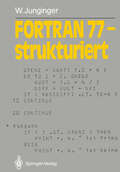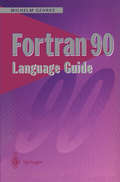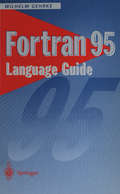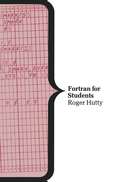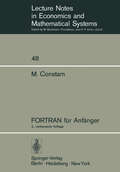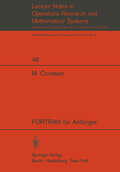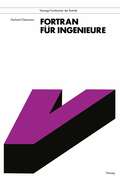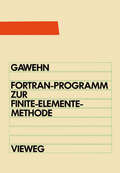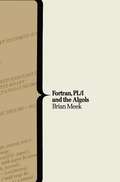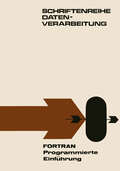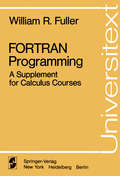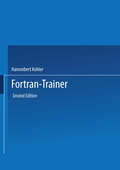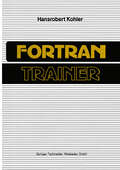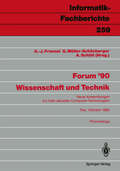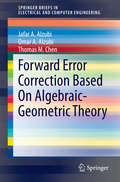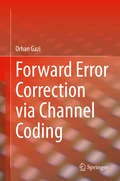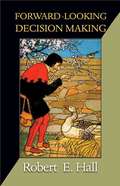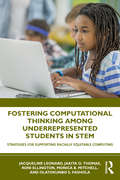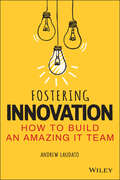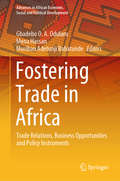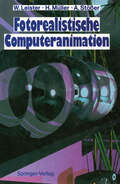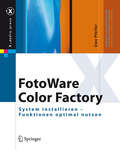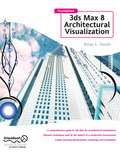- Table View
- List View
Fortran 90 Language Guide
by Wilhelm GehrkePREFACE The FORTRAN programming language was designed in the 1950s and standardized in 1966. That version of the language was later called FORTRAN 66. FORTRAN 66 quickly developed into the most important programming language for the development of engineering and scientific applications. In 1978, the language was redesigned and standardized again and called FORTRAN 77. However, this FORTRAN version was not yet a modern language as far as software engineering and programming methodology were concerned. In 1991, a new version of the language was standardized. Its name is Fortran 90. This version is a powerful tool, in fact it is closer to the state of the art of high level problem oriented programming languages than other famous languages that are used for the same area of application. The next revision of the language is planned for 1995; it will be a minor revision of Fortran 90. The next major language revision is planned for the year 2000. This "Fortran90 Language Guide" is a comprehensible description of the com plete Fortran 90 programming language as it is defined in the standard docu ment [1]. It is already in accordance with the two corrigenda [2] [3] of the standard document. The standard document is a reference book for compiler writers and those experts who already know all about Fortran 90, but it is use less for beginners and rather impractical even for experienced programmers.
Fortran 95 Language Guide
by Wilhelm GehrkeFortran is one of the most widely used programming languages in science and engineering. Fortran 90 replaced the outmoded FORTRAN 77 in 1991 and this recent version of the International Standard enhances this version. It also includes several new features to ensure that Fortran continues to be aligned with High Performance Fortran (HPF) for parallel computer architectures. Fortran 95 Language Guide will serve as a language reference manual for programmers, provide teaching material for introductory courses in Fortran programming, and give help to experienced Fortran programmers migrating to the new standard. Gehrke has provided a comprehensive and easy-to-understand description of the Fortran 95 programming language as defined by the ISO, which will be welcomed by both practitioners and students alike.
FORTRAN für Ingenieure: Eine Anleitung zum praktischen Gebrauch mit Hinweisen für Leser mit BASIC-Kenntnissen (Viewegs Fachbücher der Technik)
by Gerhard OetzmannEine der grundlegenden Fähigkeiten von Digitalrechnern ist, Informationen speichern zu können. Der Benutzer kann sich gespeicherte Informationen mitteilen lassen. Er kann Speicherinhalte vorgeben und Anweisungen formulieren, die aus gespeicherten Informa tionen neue gewinnen und wiederum speichern. Wie läuft das im einzelnen ab? Das Bit als kleinste Speichereinheit mit 2 unterscheidbaren Zuständen (meistens 0 und 1 genannt) ist für die gängigen Anwendungen eine unhandliche Größe. Die kleinste Ein heit, die im Bereich numerischer Anwendungen angesprochen wird, ist vielmehr das Speicherwort. Es umfaßt eine Gruppe von Bits, wobei die Wortlänge vom Rechnerher steller festgelegt wird. Verbreitet sind 32-Bit-Worte. Man findet aber auch Rechner mit 16-, mit 64-Bit-Worten und mit manch anderer Wortlänge. Die aktuelle Wortlänge seines Rechners braucht der Anfänger nicht zu wissen, aber er sollte sich einprägen, daß zum Speichern einer Zahl ein Wort benutzt wird - unabhängig vom Zahlenwert. Fast alle Rechner arbeiten mit fester Wortlänge. Sie können nur endlich viele Zahlen unterschei den. Insbesondere gibt es eine größte darstellbare Zahl, deren Wert man in der Regel aber auch nicht wissen muß. Will man auf ein Speicherwort zugreifen, muß man seine Lage im Speicher, seine Platz adresse kennen. Die damit verbundene Verwaltung der Speicherplätze mußte in den Kinderjahren der EDV vom Programmierer erledigt werden. In FORTRAN (und anderen Programmiersprachen) hingegen werden die Plätze symbolisch adressiert über sog. Variab len. Der Variablenname entspricht der Adresse. Verschiedene Namen bedeuten verschie dene Speicherplätze.
FORTRAN IV/77-Programm zur Finite-Elemente-Methode: Ein FEM-Programm für die Elemente Stab, Balken und Scheibendreieck
by Wilfried GawehnFortran-Trainer
by Hansrobert KohlerFallunterscheidungen durchzutesten sowie eigene einfache un- sofern vorhanden - kompliziertere Literaturbeispiele durchzurech nen. Auch schon während des Studiums sollte man sich klar darüber sein, daß der spätere Auftraggeber den Programmierer zur Rechen schaft ziehen wird, wenn durch Nachlässigkeit unvollkommene und falsche Programme ihn ein unverantwortliches Mehr an Zeit und Geld kosten. Es wird in der späteren Praxis auch der Fall sein können, daß ein Fremder Ihr Programm rechnen will - oder daß Sie selbst nach einigen Monaten durch veränderte Spezifikationen Ihr eigenes Pro gramm abändern müssen - oder ein anderer Mitarbeiter sich durch Ihr Programm, das mehrere Seiten umfassen kann, hindurchkämpfen muß. Dann muß es mit wenig Zeitaufwand möglich sein, sich dieses fremd gewordene oder fremde Programm inhaltlich wie strukturell (wieder) anzueignen. Die notwendigen Informationen enthält eine Programmbeschreibung, die man beim Einordnen des Programmes in die Bibliothek als Dokumentation hinterlegt. Sie sollte minde stens enthalten: 1. Programm - Name und - Typ (HP/UP) 2. Mathematische Grundlagen 3. Eingabe / Ausgabe Daten und zugehörige Formate 4. Abweichungen von Typ - Vereinbarung (Complex, Logical usw. ) 5. Bereiche (Dimension, Common, Equivalence) 6. (ggf. ) Parameterliste 7. Programmablaufplan / Struktogramm 8. Beispiel Auch an die Anfertigung einer Programmbeschreibung sollte man sich recht frühzeitig gewöhnen. Jede sprachliche Formulierung trägt einen signifikanten Akzent, mal kurz und bündig, mal detailliert informativ, mal mit dieser, mal mit jener Wortwahl - auch bei Programmiersprachen. Diese Nuancierungen lassen sich auch in den vorliegenden Programm Vorschlägen erkennen.
FORTRAN-Trainer
by Hansrobert KohlerNur in einfachen Fällen wird dem Programmierer eine Formel vor gegeben sein, mit der er ein Tabellenwerk für unterschiedliche Vorgaben erstellen soll. Wesentlicher ist das Programmieren von Abläufen, die sich nach bestimmten Vorschriften wiederhole- wie z. B. die iterativen und rekursiven Verfahren der numerischen Mathematik. Hierzu kann man sich in gängigen Fällen bereits be kannter Algorithmen bedienen, die dem Programmierer aus Veröffent lichungen unterschiedlicher Art zur Verfügung stehen. Aber auch diese Aufgabenstellungen erfordern in der Regel nur die Beherrschung der Programmiersprache an sich, und auf dem Weg zur Beherrschung der Sprache werden derartige übungen unumgäng lich sein. Dies gilt auch für den vorliegenden FORTRAN-Trainer. Dennoch muß man sich klar darüber sein, daß die Beherrschung der Sprache zwar für manche Studiengebiete ausreicht, daß aber das Endziel erst dann erreicht ist, wenn man in das algorithmische Denken hineingewachsen ist und auch dieses anwenden kann. So kann es Aufgabenstellungen geben, in denen der vorausgehende Denkpro zeß, wie man die Programmierung anzupacken hat, wesentlich mehr Zeit beansprucht als das Programmieren selbst. Meist sind dies Probleme, die kaum Formeln beinhalten und oft unscheinbar aus sehen, dann aber in der organisatorischen Umsetzung in ein Pro gramm erhebliche Schwierigkeiten mit sich bringen können. Wie beispielsweise können Sie n Damen derart auf ein (nxn)-Schach brett setzen, daß sie sich nicht gegenseitig schlagen können? Lassen Sie doch z. B.
Forum ’90 Wissenschaft und Technik: Neue Anwendungen mit Hilfe aktueller Computer-Technologien, Trier, 8./9. Oktober 1990 Proceedings (Informatik-Fachberichte #259)
by Hans-Jürgen Friemel Gisbert Müller-Schönberger Andreas SchüttDas Europa der 90er Jahre stellt in den verschiedensten Bereichen eine Herausforderung dar, insbesondere auch in Wissenschaft und Technik. Die Träger dieses innovativen Bereiches - die Hochschulen, Forschungsinstitute und die Industrie - sind daher aufgefordert, ihren bisher gepflegten Gedankenaustausch zu verstärken. Das "Forum '90 Wissenschaft und Technik" soll ein weiterer Meilenstein auf diesem Weg sein. Wissenschaftlern und Forschern, Entwicklern und Anwendern soll die Möglichkeit geboten werden, sich über aktuelle neue Techniken und Anwendungsgebiete zu informieren und ihre Erfahrungen auszutauschen. Mit diesem Ziel möchten die Universität Trier, die Stadt Trier, der Siemens-Informationstechnik Anwenderverein e.V. (SAVE) und die Siemens AG als gemeinsame Veranstalter ein breites Vortragsprogramm anbieten. Während des zweitägigen Forums sollen sowohl Themen von allgemein wissenschaftlichem Interesse behandelt als auch spezielle Grundprinzipien, Technologien und Anwendungsgebiete in vier verschiedenen Fachgebieten vorgestellt werden: den Geisteswissenschaften, den Wirtschaftswissenschaften, den Ingenieurwissenschaften und den Naturwissenschaften.
Forward Error Correction Based On Algebraic-Geometric Theory (SpringerBriefs in Electrical and Computer Engineering)
by Jafar A. Alzubi Omar A. Alzubi Thomas M. ChenThis book covers the design, construction, and implementation of algebraic-geometric codes from Hermitian curves. Matlab simulations of algebraic-geometric codes and Reed-Solomon codes compare their bit error rate using different modulation schemes over additive white Gaussian noise channel model. Simulation results of Algebraic-geometric codes bit error rate performance using quadrature amplitude modulation (16QAM and 64QAM) are presented for the first time and shown to outperform Reed-Solomon codes at various code rates and channel models. The book proposes algebraic-geometric block turbo codes. It also presents simulation results that show an improved bit error rate performance at the cost of high system complexity due to using algebraic-geometric codes and Chase-Pyndiah’s algorithm simultaneously. The book proposes algebraic-geometric irregular block turbo codes (AG-IBTC) to reduce system complexity. Simulation results for AG-IBTCs are presented for the first time.
Forward Error Correction via Channel Coding
by Orhan GaziThis book provides a comprehensive explanation of forward error correction, which is a vital part of communication systems. The book is written in such a way to make the subject easy and understandable for the reader. The book starts with a review of linear algebra to provide a basis for the text. The author then goes on to cover linear block codes, syndrome error correction, cyclic codes, Galois fields, BCH codes, Reed Solomon codes, and convolutional codes. Examples are provided throughout the text.
Forward-Looking Decision Making: Dynamic Programming Models Applied to Health, Risk, Employment, and Financial Stability
by Robert E. HallIndividuals and families make key decisions that impact many aspects of financial stability and determine the future of the economy. These decisions involve balancing current sacrifice against future benefits. People have to decide how much to invest in health care, exercise, their diet, and insurance. They must decide how much debt to take on, and how much to save. And they make choices about jobs that determine employment and unemployment levels. Forward-Looking Decision Making is about modeling this individual or family-based decision making using an optimizing dynamic programming model. Robert Hall first reviews ideas about dynamic programs and introduces new ideas about numerical solutions and the representation of solved models as Markov processes. He surveys recent research on the parameters of preferences--the intertemporal elasticity of substitution, the Frisch elasticity of labor supply, and the Frisch cross-elasticity. He then examines dynamic programming models applied to health spending, long-term care insurance, employment, entrepreneurial risk-taking, and consumer debt. Linking theory with data and applying them to real-world problems, Forward-Looking Decision Making uses dynamic optimization programming models to shed light on individual behaviors and their economic implications.
Fostering Computational Thinking Among Underrepresented Students in STEM: Strategies for Supporting Racially Equitable Computing
by Jacqueline Leonard Jakita O. Thomas Roni Ellington Monica B. Mitchell Olatokunbo S. FasholaThis book broadly educates preservice teachers and scholars about current research on computational thinking (CT). More specifically, attention is given to computational algorithmic thinking (CAT), particularly among underrepresented K–12 student groups in STEM education. Computational algorithmic thinking (CAT)—a precursor to CT—is explored in this text as the ability to design, implement, and evaluate the application of algorithms to solve a variety of problems. Drawing on observations from research studies that focused on innovative STEM programs, including underrepresented students in rural, suburban, and urban contexts, the authors reflect on project-based learning experiences, pedagogy, and evaluation that are conducive to developing advanced computational thinking, specifically among diverse student populations. This practical text includes vignettes and visual examples to illustrate how coding, computer modeling, robotics, and drones may be used to promote CT and CAT among students in diverse classrooms.
Fostering Computational Thinking Among Underrepresented Students in STEM: Strategies for Supporting Racially Equitable Computing
by Jacqueline Leonard Jakita O. Thomas Roni Ellington Monica B. Mitchell Olatokunbo S. FasholaThis book broadly educates preservice teachers and scholars about current research on computational thinking (CT). More specifically, attention is given to computational algorithmic thinking (CAT), particularly among underrepresented K–12 student groups in STEM education. Computational algorithmic thinking (CAT)—a precursor to CT—is explored in this text as the ability to design, implement, and evaluate the application of algorithms to solve a variety of problems. Drawing on observations from research studies that focused on innovative STEM programs, including underrepresented students in rural, suburban, and urban contexts, the authors reflect on project-based learning experiences, pedagogy, and evaluation that are conducive to developing advanced computational thinking, specifically among diverse student populations. This practical text includes vignettes and visual examples to illustrate how coding, computer modeling, robotics, and drones may be used to promote CT and CAT among students in diverse classrooms.
Fostering Innovation: How to Build an Amazing IT Team
by Andrew LaudatoProven and practical strategies for leading IT teams and departments In Fostering Innovation: How to Build an Amazing IT Team, accomplished technology strategist, executive, and leader Andrew Laudato delivers an eye-opening exploration of how to design, build, staff, and run a high-performing IT department. The book is filled with universally applicable strategies and techniques that can transform any IT team into an all-star cast perfectly aligned with your organization’s objectives. Incorporating proven and practical processes throughout the narrative, the book offers useful continuous improvement concepts the reader can apply to their team, company, and professional development. Readers will also find: Foolproof ways to put people before technology Detailed discussions of perennially important topics, like the importance of uptime, how to deploy redundancy, and creating the perfect organization chart Strategies for managing and motivating the wonderfully unique individuals we refer to as "technologists." The perfect resource for newly minted Chief Information Officers and Chief Technology Officers, Fostering Innovation will also earn a place in the libraries of non-technical professionals who work closely with IT, and business leaders seeking a better understanding of how to lead an IT team.
Fostering Innovation: How to Build an Amazing IT Team
by Andrew LaudatoProven and practical strategies for leading IT teams and departments In Fostering Innovation: How to Build an Amazing IT Team, accomplished technology strategist, executive, and leader Andrew Laudato delivers an eye-opening exploration of how to design, build, staff, and run a high-performing IT department. The book is filled with universally applicable strategies and techniques that can transform any IT team into an all-star cast perfectly aligned with your organization’s objectives. Incorporating proven and practical processes throughout the narrative, the book offers useful continuous improvement concepts the reader can apply to their team, company, and professional development. Readers will also find: Foolproof ways to put people before technology Detailed discussions of perennially important topics, like the importance of uptime, how to deploy redundancy, and creating the perfect organization chart Strategies for managing and motivating the wonderfully unique individuals we refer to as "technologists." The perfect resource for newly minted Chief Information Officers and Chief Technology Officers, Fostering Innovation will also earn a place in the libraries of non-technical professionals who work closely with IT, and business leaders seeking a better understanding of how to lead an IT team.
Fostering Trade in Africa: Trade Relations, Business Opportunities and Policy Instruments (Advances in African Economic, Social and Political Development)
by Gbadebo O. A. Odularu Mena Hassan Musibau Adetunji BabatundeThis book discusses trade relations and facilitation issues at both the regional and the continental African level, highlighting the increasing business opportunities and challenges that confront Africa in the digital age. It also examines the effects of trade policies and other policy instruments on Africa’s economic development and presents workable policy measures for a more business-friendly ecosystem. Discussing various topics, including trade relations between African countries, African and international trade agreements, and trade liberalization policies, the book appeals to scholars of economics, business and management as well as professionals and policymakers interested in fostering free trade and sustainable business development in Africa.
Fotorealistische Computeranimation
by Wolfgang Leister Heinrich Müller Achim StößerDie heutige Computergraphik in ihren vielfältigen Anwendungen zeigt eine Tendenz zu Farbe und Bewegung. Die immer häufiger als Vorspann, in Werbespots, aber auch in wissenschaftlichen Visualisierungen verwendeten rechnergenerierten Animationen erzielen ihre Wirkung durch die Simulation optischer Effekte, etwa des Reflexionsverhaltens metallischer Oberflächen, und durch ausgefeilte Bewegungsabläufe bis hin zu korrektem physikalischen Verhalten. In diesem Buch werden Techniken zur Produktion derartiger fotorealistischer Computeranimationen vorgestellt und anhand des Computerfilms Occursus cum Novo demonstriert. Die Kapitel werden durch Übersichten zum Stand der Technik und Verweise auf relevante weiterführende Literatur abgeschlossen. Für potentielle Entwickler von Animationssystemen werden in diesem Buch grundlegende Verfahren und ihre effiziente Umsetzung in Algorithmen und Software dargestellt. Anwender erfahren technische Einzelheiten, die helfen können, die Wirkungsweise der eingesetzten Systeme besser zu verstehen. Das umfangreiche, überwiegend farbige Bildmaterial vermittelt auch dem nicht technisch orientierten Leser den "Stand der Kunst".
FotoWare Color Factory: System installieren - Funktionen optimal nutzen (X.media.press)
by Uwe PfeiferKostensenkung durch Automatisierung ist ein wichtiges Thema in allen Reproabteilungen. Color Factory von FotoWare leistet auf diesem Gebiet Enormes, vorausgesetzt die Software ist effizient konfiguriert. Dieses Buch hilft Anwendern, die das Produkt bereits lizensiert haben, dessen Konfiguration zu optimieren und bietet Denkanstöße für Lösungen. Interessenten von Color Factory erhalten einen Überblick über Leistungen und Einsatzmöglichkeiten. Die anschauliche Darstellung der Features ermöglicht es, die Information schnell aufzunehmen. Schwerpunkt bildet die automatisierte Bildbearbeitung, die über ein sehr hohes Einsparpotenzial verfügt.
Foundation 3ds Max 8 Architectural Visualization
by Brian L. Smith* This is the only book on the market covering 3Ds max for Architectural visualizations, one of the most common uses of 3Ds Max. * Includes quickstart tutorial sections to get the reader up and running as quickly as possible. * It will be one of the first books to come out about the new version of the product.
